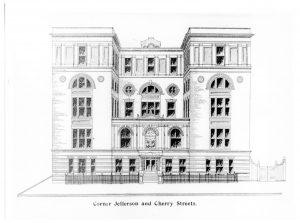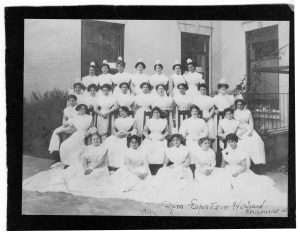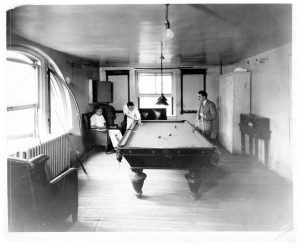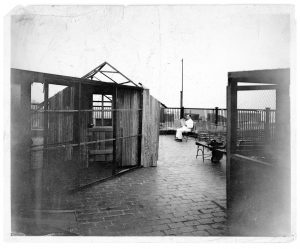Sep 28, 2021
See Building Beth Israel, Part 1: Foundations for the first part of this series. An interactive map of Beth Israel historical locations is available here. More archival material about the Jefferson and Cherry Streets location is here.
For much of the 1890s, the first decade of its existence, the location of Beth Israel Hospital was a moving target. The hospital moved from a factory loft, to an “old-fashioned parlor floor,” to two different rented hospital facilities. In its final locations during this period, split between buildings at 206 East Broadway and 195 Division Street, Beth Israel Hospital was financially solvent for the first time, enabling it to finally buy land of its own. In 1896, Beth Israel purchased a plot of land at Jefferson and Cherry Streets for the construction of a new hospital building.
In 1899, the Beth Israel Board of Directors chose a design for the new hospital. The cornerstone of the building was laid on April 1, 1900.
Much of the early funding for the new location was put up by Beth Israel’s Board of Directors, which, in addition to a mortgage, allowed for the purchase of the lot. However, the cost for the chosen design was well above initial expectations, and the final estimate was around $200,000 (about $6.5 million in 2021 dollars), requiring a significant fundraising effort.
On May 26, 1902, the new Beth Israel Hospital at Jefferson and Cherry Streets was dedicated. It included 134 beds, with male, female, and maternity wards as well as private rooms. It featured a solarium, a common feature for hospitals at that time, in addition to outdoor space on the roof for staff and patient use. The Beth Israel Hospital Training School for Nurses was founded in 1904 and moved into this building. (Today, it is the Phillips School of Nursing at Mount Sinai Beth Israel.)
By August 1912, a physiological chemistry laboratory opened at Beth Israel under the direction of Max Kahn, PhD. The laboratory was located on the top floor and could comfortably hold five people. Additionally, after extensive delays, a children’s ward opened in January 1919, but it was forced to close six months later because of the nursing shortage caused by the Influenza Epidemic of 1918. Both the children’s and maternity wards were closed and re-opened periodically, based on available financial and staff support.
As early as 1915, the Beth Israel Board of Directors began to purchase property on Livingston Place along Stuyvesant Square Park. Plans to move to this new location were delayed first by World War I, and then by the influenza epidemic. Construction began in earnest in 1922, and Beth Israel finally moved to its current location in the Dazian Pavillion in 1929, giving up the Jefferson and Cherry Streets location. While it wasn’t the Hospital’s final location, Jefferson and Cherry Streets is where Beth Israel Hospital came of age and began to resemble the hospital of today.
Authored by Stefana Breitwieser, Digital Archivist
Oct 16, 2020
Our web archives are available online here.
In March 2020, the world began witnessing history in real-time, and archivists scrambled to ensure that the story of COVID-19 would be well-preserved. But with so much happening at a distance, much of the communication and ephemera created in the last six months is online, meaning that archivists have had to eschew traditional practices in collecting physical material and focus increasingly on the enormous amount of material now online. For example, at the peak of the crisis, healthcare institutions like Mount Sinai were updating their websites multiple times a day so that staff and the public had the best and most recent information on policies and procedures regarding things like new treatments and personal protective equipment. This type of information will be valuable moving forward as historians try to understand a rapidly evolving crisis.
Fortunately, technology exists to capture every version of these websites as they appear online. Web archiving has been a practice since the late-1990s, and since 2015 the Aufses Archives has used Archive-It, a web archiving service provided by the Internet Archive, to regularly capture information related to the Mount Sinai Health System. We also use this tool to capture web content related to the response to COVID-19, as well as day-to-day changes to the website.
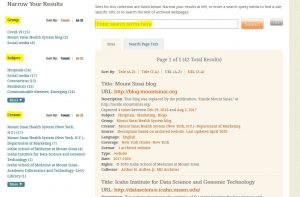
Screenshot of the Aufses Archives page on Archive-It.
The easiest way to access our web archives is to browse the list of websites on the main screen. These results can be filtered using the groups, subjects, or creators on the left side of the screen. You can also use the search bar at the top of the screen to search the metadata created by the archivist. (We expect our COVID-19 group to be the most used group for the foreseeable future.) Information on COVID-19, as well as a wide range of subjects, has been collected by a number other academic institutions, and you can also browse their collections here.
If you’re searching for a particular webpage instead of a whole website, or if you’re trying to search the original text of a website, the “Search Page Text” option may be of use. This feature supports keyword searching of individual web pages, much like Google. However, you can also filter by “Capture date range” which means you can search not just across subjects, but also across time.

Screenshot of the “Search Page Text” functionality in Archive-It, after searching “COVID-19.”
With either searching method, once you’ve selected a link, you’ll be taken to a page of dates, each corresponding to a particular date of capture. While there’s no guarantee that every version of the website was captured, it will at least give you a sense of how the site has progressed over time.

This page, related to the COVID-19 pandemic, had 72 captures at the time of writing, starting every day from March 23, 2020, to May 12, 2020. The crawl now occurs monthly, due to fewer updates of the website.
Once you’ve selected a date, you’re taken to a version of the website captured on that date. Shown below is our earliest Archive-It capture of the Mount Sinai Hospital homepage, as it appeared in February 2015. The website should play back in the same was as it originally appeared.

Of course, the Mount Sinai Health System only represents a very small corner of the internet, and archivists are working to capture as much as possible. All the websites captured by the Aufses Archives contribute directly to the Internet Archives’ Wayback Machine, which at the time of writing has 477 billion website captures, including a limited number of Mount Sinai webpages dating back to the 1990s, captured on an ad hoc basis. You can also contribute by adding URLs via the link on the Wayback homepage.
Authored by Stefana Breitwieser, Digital Archivist
Mar 18, 2016
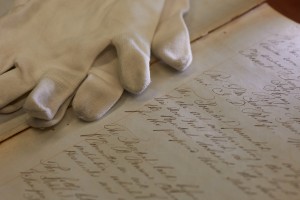 The Mount Sinai Archives is very happy to announce the unveiling of our new website. The new main page has gathered together under easy drop-down sections all of the information that was formerly embedded in text and hard to find. (We also really like the images that adorn the tops of the pages.) Our site now matches the style of our institutional web presence and, most importantly, provides much better visibility to our electronic resources. We have gathered onto the Digital Collections page a link to our digital repository, DSpace, a link to our image database, as well as a link to our digitized AV collection. Soon we will be updating the main pages of those programs as well, and we hope over the course of this year to be able to add a site for our oral history collection, which dates back to the 1960’s and features interviews with Mount Sinai physicians and leaders. Also of note is that on the Historical Resources page, we have gathered together links to digitized versions of histories relating to Mount Sinai, its staff and departments.
The Mount Sinai Archives is very happy to announce the unveiling of our new website. The new main page has gathered together under easy drop-down sections all of the information that was formerly embedded in text and hard to find. (We also really like the images that adorn the tops of the pages.) Our site now matches the style of our institutional web presence and, most importantly, provides much better visibility to our electronic resources. We have gathered onto the Digital Collections page a link to our digital repository, DSpace, a link to our image database, as well as a link to our digitized AV collection. Soon we will be updating the main pages of those programs as well, and we hope over the course of this year to be able to add a site for our oral history collection, which dates back to the 1960’s and features interviews with Mount Sinai physicians and leaders. Also of note is that on the Historical Resources page, we have gathered together links to digitized versions of histories relating to Mount Sinai, its staff and departments.
Please, check out our new website, and let us know if you have any comments or questions. We can be reached at MSarchives@mssm.edu.
[Edit: As of Summer 2022, the Archives no longer uses DSpace.]
